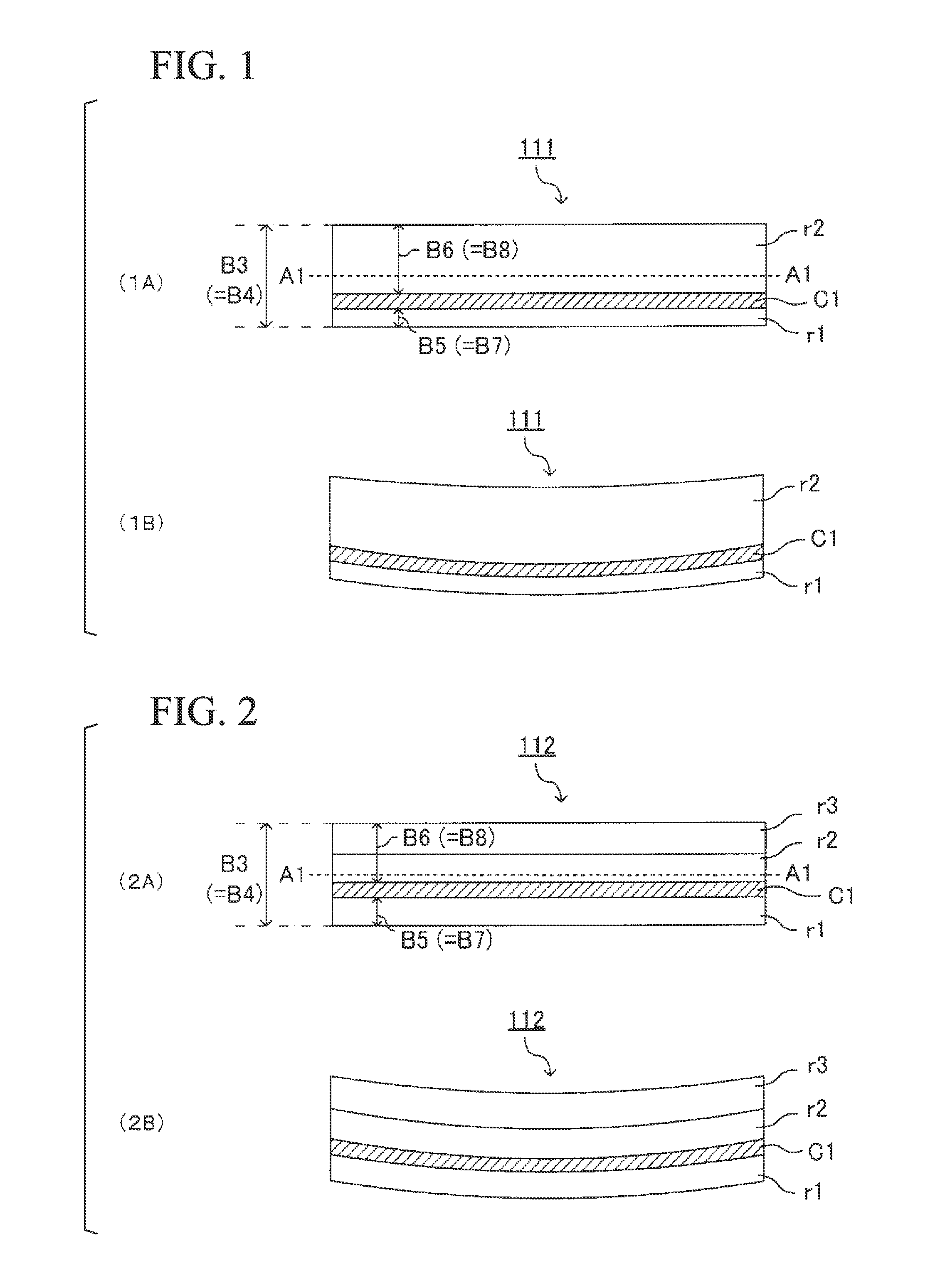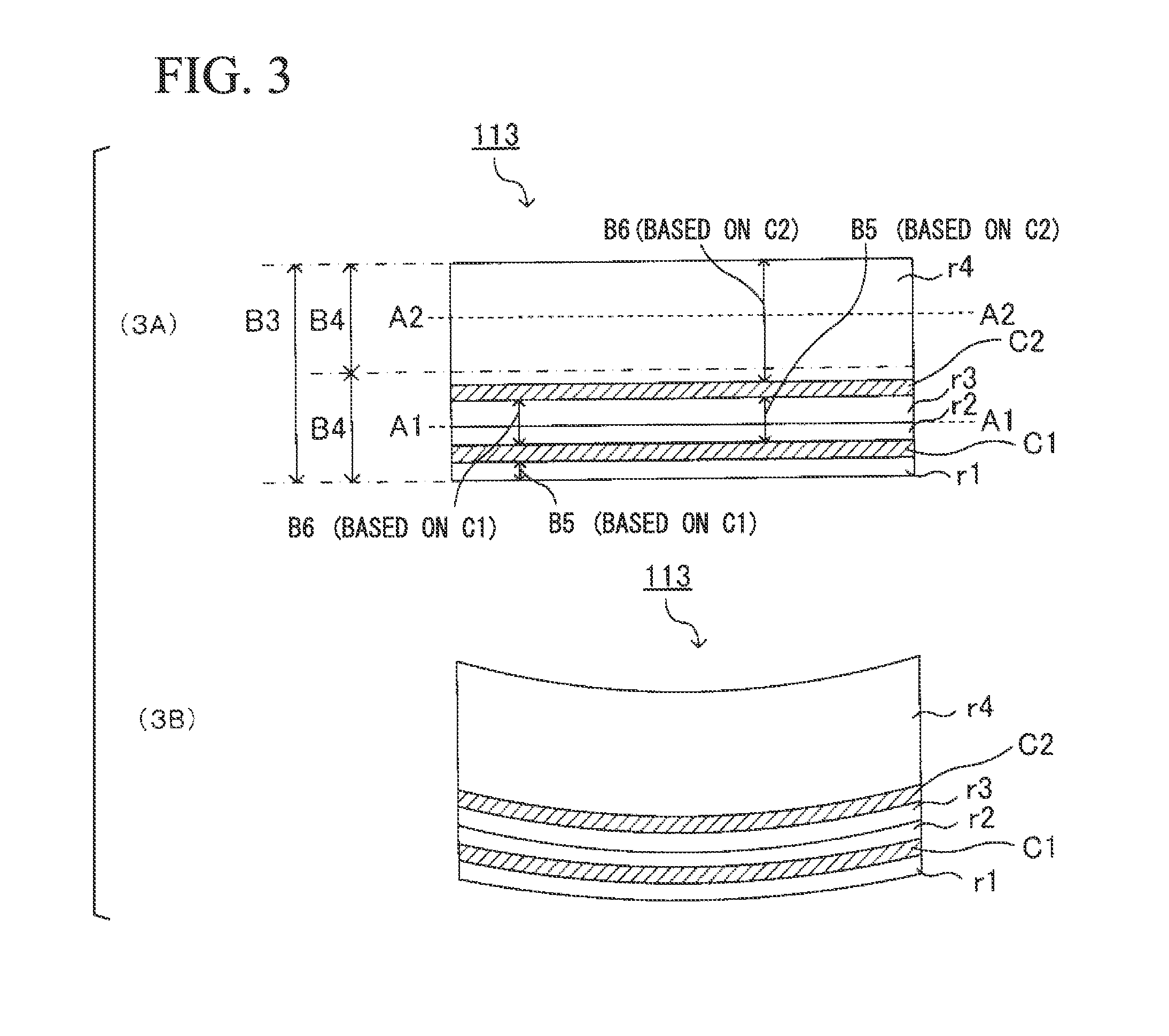Insulating substrate, metal-clad laminate, printed wiring board and semiconductor device
a technology of printed wiring boards and substrates, which is applied in the direction of semiconductor/solid-state device details, transportation and packaging, and other domestic articles, can solve the problems of increased susceptibility to warping, increased susceptibility to problems, and decreased reliability, so as to achieve high design freedom and control the direction and degree of warping
- Summary
- Abstract
- Description
- Claims
- Application Information
AI Technical Summary
Benefits of technology
Problems solved by technology
Method used
Image
Examples
example 1
1. Production of Metal-Clad Laminate
[0243]A 12 μm copper foil (Mitsui Mining and Smelting Co., Ltd., 3EC-VLP Foil) was superimposed on both sides of Prepreg 1 followed by subjecting to heated pressure molding for 2 hours at 220° C. and 3 MPa to obtain a metal-clad laminate. The core layer (portion composed of an insulating substrate) of the resulting metal-clad laminate had the same layer composition as that of the insulating substrate 111 of FIG. 1A, had a layer composition obtained by laminating in order starting from a first side the resin layer r1, the fibrous base material layer C1 and the resin layer r2, the thicknesses of each layer were 3 μm for r1, 28 μm for C1 and 9 μm for r2, and the aforementioned core layer was such that the fibrous base material layer C1 was shifted towards the resin layer r1 with respect to a reference position. In addition, the total thickness (B3) of the core layer was 40 μm.
[0244]The ratio of B5 / B6 of the aforementioned core layer was 0.33 since th...
examples 2 to 5
[0254]Printed wiring boards and semiconductor devices of Examples 2 to 5 were produced in the same manner as Example 1 with the exception of respectively producing metal-clad laminates using Prepreg 2 in Example 2, Prepreg 3 in Example 3, Prepreg 5 in Example 4 and Prepreg 6 in Example 5, and using the resulting metal-clad laminates as core substrates. In the core substrates of Examples 2 to 5, the fibrous base material layers were shifted towards the first side with respect to a reference position. Furthermore, semiconductor elements were mounted on printed wiring boards for a semiconductor device so that the side on the opposite side from the side in the direction in which the fibrous base material layer of the core substrate is shifted is the side where the semiconductor element is mounted.
example 6
1. Production of Metal-Clad Laminate
[0255]A total of three prepregs were laminated in the order of Prepreg 10, Prepreg 10 and Prepreg 4 so that the second resin layer of Prepreg 4 was on the side of Prepreg 10 and the first resin layer was on the side of an air layer, 12 μm copper foil (Mitsui Mining and Smelting Co., Ltd., 3EC-VLP Foil) was superimposed on both sides of the resulting laminate followed by subjecting to heated pressure molding for 2 hours at 220° C. and 3 MPa to obtain a metal-clad laminate. The core layer (portion composed of an insulating substrate) of the resulting metal-clad laminate had the same layer composition as that of the insulating substrate 115 of FIG. 5A, and had a layer composition obtained by laminating in order starting from a first side the resin layer r1, the fibrous base material layer C1, the resin layers r2 and r3, the fibrous base material layer C2, the resin layers r4 and r5, the fibrous base material layer C3 and the resin layer r6. The thick...
PUM
| Property | Measurement | Unit |
|---|---|---|
| Thickness | aaaaa | aaaaa |
| Thickness | aaaaa | aaaaa |
| Size | aaaaa | aaaaa |
Abstract
Description
Claims
Application Information
 Login to View More
Login to View More - R&D
- Intellectual Property
- Life Sciences
- Materials
- Tech Scout
- Unparalleled Data Quality
- Higher Quality Content
- 60% Fewer Hallucinations
Browse by: Latest US Patents, China's latest patents, Technical Efficacy Thesaurus, Application Domain, Technology Topic, Popular Technical Reports.
© 2025 PatSnap. All rights reserved.Legal|Privacy policy|Modern Slavery Act Transparency Statement|Sitemap|About US| Contact US: help@patsnap.com



